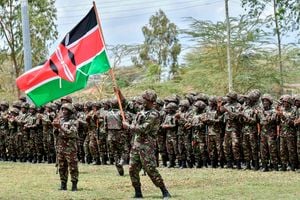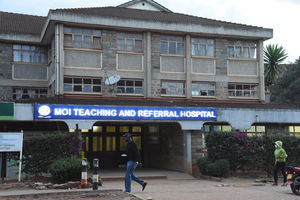Coffee reforms: Will Ruto succeed where predecessors failed?

A farmer tends to his coffee in Nyeri town on November 17, 2022.
Successive Kenyan governments have tried to reform the coffee sector to enhance farmers’ livelihoods, but there is little to show from these efforts.
An average Kenyan peasant farmer earns about Sh10,000 annually from coffee. With an average of four children, this income is hardly enough for food, clothes, school fees and other household expenses.
Little wonder that most farmers uprooted coffee in the 1990s. Those who still have hope in it walk around in tattered clothes. Coffee prices seem to be recovering, but this is a result of the normal demand and supply cycle and not a reflection of meaningful reforms in this once golden sector.
Dr Ruto is no layman in agriculture, having handled that docket as a Cabinet minister. With his ‘bottom up’ economics, he certainly has insights about the sector. However, there is more noise about removing ‘Uhuru’s cartels in the coffee sector’ than concrete measures to put more money into farmers’ pockets.
When Kibaki came to power, coffee reforms were premised on ‘removing Moi’s cartels’. It is always a red herring.
The international coffee quota system collapsed in 1988, ushering in a free-for-all market. Before this, the International Coffee Agreement regulated coffee supply to stabilise prices. It was a producer-led market. Kenya was assigned 60,000 tons out of the 150,000 tons it produced annually in the 1980s.
Brazil, then the biggest producer, would sometimes would dump its excess coffee into the sea, just to stabilise prices.
Collapse of quotas
The collapse of the coffee quotas was related to the end of the cold war. Before then, the West supported coffee-producing countries to prevent Russia from getting a foot-hold in friendly coffee producers like Kenya.
The collapse of the Soviet Union suddenly triggered the ‘free trade’ campaign by the West, leading to a consumer-led market. Vietnam replaced Brazil, not as the new mother hen, but the chief market-flooding producer.
Western traders bought cheap coffee as the prices plunged. Today, less than 10 multinationals control the global coffee trade; Nestlé, Kraft Foods and Sara Lee, and roasters like Smucker’s, Strauss, Starbucks and Tchibo. They predictably prioritise profits over the welfare of farmers and the sustainability of production. Notably, they have enough stocks to last years.
The downline is that the coffee we produce is not really ours beyond the factory. It is impossible to go back to the pre-1989 quota model. However, favourable opportunities have emerged from the chaos of the post-cold war market configuration.
First off, there is a growing market for high-quality coffee grown in a particular way. Indonesia has made a name with a special coffee called Kopi Luwak, made from beans collected from monkey poop. Specialty and gourmet markets are worth billions of dollars in the US and Europe.
Secondly, small-scale coffee farmers could explore selling coffee directly to consumers. This can be done online. Some cooperatives in Nyeri are already earning from this model.
Thirdly, fair trade certification can earn farmers more by giving guarantees to consumers that their coffee is produced through sustainable and equitable business practices.
Fourthly, there is a huge unexplored coffee market in China and India. Again, the ever-expanding middle class in Kenya can be turned into a coffee market through a sustained campaign. Kilele coffee in Nyeri is an example of a nascent coffee culture.
In short, there is so much that can be done to improve coffee farmers’ incomes. But this requires cooperation between the government, civil society, NGOs and farmers.
Dr Mbataru teaches Public Policy at Kenyatta University; [email protected]





